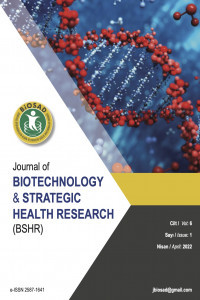Türkiye'de COVID-19 aşı tereddütünün YouTube analiz yöntemi ile araştırılması
YouTube analizi, COVID-19, aşı, aşı karşıtlığı, toplum davranışları, Türkiye.
Investigation of COVID-19 vaccine hesitation in Turkey with YouTube analysis method
YouTube analysis, COVID-19, vaccine, anti-vaccination, community behaviors, Turkey,
___
- 1. https://www.worldometers.info/coronavirus/ [Access date: 22.02.2021]
- 2. Evolution of the COVID-19 vaccine development landscape. (n.d.). Retrieved September 8, 2020, from https://www.nature.com/articles/d41573-020-00151- 8?S=03
- 3. Yıldırım, S. Salgınların Sosyal-Psikolojik Görünümü: Covid-19 (Koronavirüs) Pandemi Örneği. Electronic Turkish Studies.2020; 15(4):1331-1351.
- 4. Rzymski P, Borkowski L, Drąg M, et al. The strategies to support the COVID-19 vaccination with evidence-based communication and tackling misinformation. Vaccines. 2021; 9(2):109.
- 5. Yenal S. COVID-19 Salgınının Uluslararası Güvenlik Açısından Değerlendirilmesi. Electronic Turkish Studies.2020; 15(4): 1315-1329.
- 6. Dindar Demiray E, Alkan Çeviker S. Aşı ve Toplumsal Korunma. J Biotechinol & Strategic Health Res. 2020; 4: 37-44.
- 7. Kutlu HH, Altındiş M. Anti-Vaccination. Flora.2018;23(2):47-58.
- 8. Bozkurt AP, Aras I. Cleft Lip and Palate YouTube Videos: Content Usefulness and Sentiment Analysis. Cleft Palate Craniofac J. 2021;58(3):362-368.
- 9. Faul F, Erdfelder E, Lang AG, et al. G*Power 3: a flexible statistical power analysis program for the social, behavioral, and biomedical sciences. Behav Res Methods. 2007;39(2):175-191.
- 10. Abul-Fottouh D, Song MY, Gruzd A. Examining algorithmic biases in YouTube's recommendations of vaccine videos. Int J Med Inform. 2020; 140:104175. doi: 10.1016/j.ijmedinf.2020.104175.
- 11. Charnock D, Shepperd S, Needham G, et al. DISCERN: an instrument for judging the quality of written consumer health information on treatment choices. J Epidemiol Community Health.1999;53(2):105-111. doi:10.1136/jech.53.2.105
- 12. Wu V, Lee DJ, Vescan A, et al. Evaluating YouTube as a Source of Patient Information for Functional Endoscopic Sinus Surgery. Ear Nose Throat J. 2020:145561320962867. doi: 10.1177/0145561320962867.
- 13. Gokcen HB, Gumussuyu G. A Quality Analysis of Disc Herniation Videos on YouTube. World Neurosurg. 2019: S1878-8750(19)30246-3. doi: 10.1016/j.wneu.2019.01.146.
- 14. Silberg WM, Lundberg GD, Musacchio RA. Assessing, controlling, and assuring the quality of medical information on the internet: Caveant lector et viewor--let the reader and viewer beware. JAMA. 1997;277(15):1244–1245.
- 15. Aydin MF, Aydin MA. Quality and reliability of information available on YouTube and Google pertaining gastroesophageal reflux disease. Int J Med Inform. 2020; 137:104107. doi: 10.1016/j.ijmedinf.2020.104107.
- 16. Yilmaz H, Aydin MN. YouTube™ video content analysis on space maintainers. J Indian Soc Pedod Prev Dent. 2020;38(1):34-40.
- 17. Covolo L, Ceretti E, Passeri C, et al. What arguments on vaccinations run through YouTube videos in Italy? A content analysis. Hum Vaccin Immunother. 2017;13(7):1693–1699.
- 18. Teng S, Khong KW, Pahlevan Sharif S, et al. YouTube Video Comments on Healthy Eating: Descriptive and Predictive Analysis. JMIR Public Health Surveill. 2020;6(4): e19618. doi: 10.2196/19618.
- 19. St Lawrence S, Hallman J, Sherony R. Video from user-generated content as a source of pre-crash scenario naturalistic driving data. Traffic Inj Prev. 2020:1-3. doi: 10.1080/15389588.2020.1829920. Epub ahead of print. PMID: 33155861.
- 20. Hernández-García I, Giménez-Júlvez T. YouTube as a Source of Influenza Vaccine Information in Spanish. Int J Environ Res Public Health. 2021;18(2):727. doi: 10.3390/ijerph18020727.
- 21. Aquino F, Donzelli G, De Franco E, et al. The web and public confidence in MMR vaccination in Italy. Vaccine. 2017; 35:4494–44948.
- 22. Yiannakoulias N, Slavik CE, Chase M. Expressions of pro- and anti-vaccine sentiment on YouTube. Vaccine. 2019;37(15):2057-2064. doi: 10.1016/j.vaccine.2019.03.001.
- 23. Tran BX, Boggiano VL, Nguyen LH, et al. Media representation of vaccine side effects and its impact on utilization of vaccination services in Vietnam. Patient Prefer Adherence. 2018;12:1717-1728.
- 24. Donzelli G, Palomba G, Federigi I, Aquino F, Cioni L, Verani M, et al. Misinformation on vaccination: A quantitative analysis of YouTube videos. Hum Vaccin Immunother. 2018;14(7):1654-1659.
- Yayın Aralığı: Yılda 3 Sayı
- Başlangıç: 2017
- Yayıncı: Deneysel, Biyoteknolojik, Klinik ve Stratejik Sağlık Araştırmaları Derneği
Muhammet SEVİNDİK, Şerif Bora NAZLI, Orhan Murat KOÇAK
Serpil MIZRAKÇI, Mukerrem GUVEN, Sevil ALKAN
VERTEBRAL OSTEOMYELİT KONULU YAYINLARIN BİBLİYOMETRİK ANALİZ YÖNTEMİ İLE İNCELENMESİ
YouTube gebelik döneminde covid 19 aşılaması üzerine etkili mi
Şükran DOĞRU, Fatih AKKUŞ, Aslı ALTINORDU ATCI
COVID-19 Enfeksiyonu Sonrası Gelişen Telogen Effluvium: Vaka Sunumu
Erkut ETÇİOĞLU, Muhammet Raşit AYDIN
Laboratuvar parametreleri ve oranlarının COVID-19 enfeksiyonunda prognoz ve mortalite ile ilşkisi
Hasan ERGENÇ, Zeynep ERTÜRK, İbrahim Hakkı TÖR, Songül ARAÇ, Mustafa USANMAZ, Cengiz KARACAER, Gülsüm KAYA
Türkiye'de COVID-19 aşı tereddütünün YouTube analiz yöntemi ile araştırılması
Sevil ALKAN, Bülent AKKAYA, Hatice ÖNTÜRK AKYÜZ
İlknur BIYIK, Yeliz TANRIVERDİ ÇAYCI, Ege Berke ATIGAN, Asuman BIRINCI
SARS-CoV-2 Enfeksiyonu ve Karaciğer tutulumu
Mehmet ÇOBAN, Dilşat GÜNDOĞDU ÇOBAN, Öner ÖZDEMİR
COVID-19 pandemisinin dermatoloji polikliniğinde tanı dağılımına etkisi
Nur Cihan COŞANSU, Mahizer YALDIZ, Bahar SEVİMLİ DİKİCİER, Ünal ERKORKMAZ
